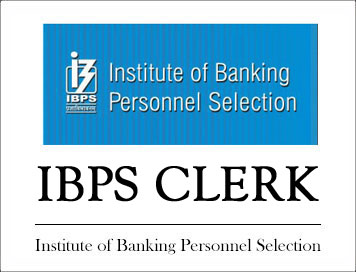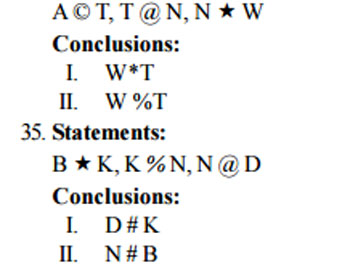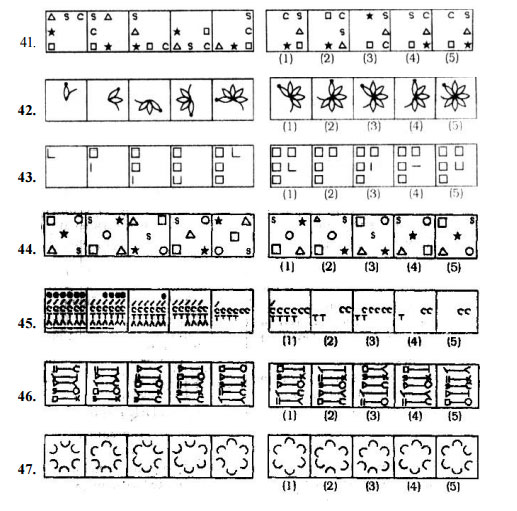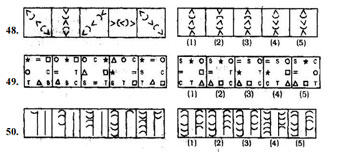(Papers) IBPS Clerk Previous Year Exam Paper "Held on 27-11-2011, 2nd Sitting - Reasoning" (West Zone)

(Papers) IBPS Clerk Previous Year Exam Paper "Held on 27-11-2011, 2nd Sitting - Reasoning" (West Zone)
1. In a certain code ROBUST is written as ‘593127’ and BONE is written as ‘3964’. How is SORE written in that: code?
(1) 2934
(2) 2594
(3) 2954
(4) 3954
(5) None of these
2. How many such pairs of letters are there in the word SPORADIC (in both forward and backward direction) each of which has as many letters -
between them in the word as in the English alphabet?
(1) None
(2) One
(3) Two
(4) Three
(5) More than three
3. In a certain code TOWN is written as ‘POSV and CARE is written as ‘BFBQ’. How is BELT written in that code?
(1) FUAK
(2) DSCM
(3) DSAK
(4) FUCM
(5) None of these
4. The positions of how many digits in the number 9671285 will remain unchanged after the digits within the number are rearranged in ascending
order from left to right?
(1) None
(2) One
(3) Two
(4) Three
(5) More than three
5. How many meaningful English words can be formed - not ending with E - with the second, the fourth, the sixth and the ninth letters of the word PROACTIVE ? (To be counted from left side)
(1) One
(2) Two
(3) Three
(4) Four
(5) More than four
DOWNLOAD IBPS CLERK Question Papers PDF
DOWNLOAD IBPS PO Question Papers PDF
DOWNLOAD MORE BANK EXAMS E-BOOKS
Printed Study Material for IBPS Clerk Exam
Printed Study Material for IBPS PO Exam
Directions (6-10) : Each of the questions below consists of a question and two statements numbered I and II given below it. You have to decide whether the data provided in the statements are sufficient to answer the question. Read both the statements and--
Give answer (1) if the data in statement I alone are sufficient to answer the question, while the data in statement II alone are not sufficient to answer the question
Give answer (2) if the data in statement II alone are sufficient to answer the question, while the data in statement I alone are not sufficient to answer the question
Give answer (3) if the data either in statement I alone or in statement II alone are sufficient to answer the question
Give answer (4) if the data given in both the statements I and II together are not sufficient to answer the question, and
Give answer (5) if the data in both the statements I and II together are necessary to answer the question.
6. In a row of twenty students facing North, what is P’s position from the right end?
I. Q is fifth to the right of P and eighteenth from the left end of the row.
II. M is third to the left of P and eleventh from the right end of the row.
7. How many daughters does D have?
I. M and K are sisters of T.
II. T’s mother is wife of D
8. How is ‘come’ written in a code language?
I. ‘come and go’ is written as ‘je ta ma’ in that code language.
II. ‘go back and’ is written as ‘ta sa je’ in that code language
9. On which day of the week definitely was R’s birthday?
I. R celebrated his birthday after Monday but before Saturday.
II. R’s sister visited R on his birthday after Wednesday.
10. Among A, B, C, D and E, each securing different marks in an examination, whose position is last but one among them?
I. D has secured less marks than only C and E:
II. B has secured more marks than A.
11. Mohan walked 30 metres towards West, took a right turn and walked 20 metres. He then took a left turn and walked 40 metres and stopped.
Towards which direction was he from the starting point?
(1) West
(2) North
(3) South-West
(4) North-West
(5) Data inadequate
Directions (12-15) : Study the following arrangement of numbers, letters and symbols carefully and answer the questions given below:
M 5 $ T @ 2 J © D F I 9 W P # E 3 8 I 6 NA T U 7 Z 4
12. How many such symbols are there in the above arrangement, each of which is immediately preceded by a number and immediately followed by a consonant?
(1) One
(2) Two
(3) Three
(4) Four
(5) More than four
13. Which of the following is exactly in the middle between tenth element from the left end and eighth element from the right end?
( l) E
(2) 3
(3) #
(4) E or #
(5) None of these
14. If the positions of the first sixteen elements in the above arrangement are reversed, which of the following will be the eighteenth from the right end’)
(l) J
(2) @
(3) 9
(4) F
(5) None of these
15. How many such consonants are there in the above arrangement, each of which is preceded by a number and not immediately followed by a symbol?
(1) None
(2) One
(3) Two
(4) Three
(5) More man three
Directions (16-20): Study the following information carefully and answer the questions given below: P, Q, R, S, T, V, W and Z are sitting around a circular table facing the centre but not necessarily in the same order. S is third to the right of P. P is second to the right of’ V, R is second to the left of V and third to the right of Q. W is not an immediate neighbour of Z is second to the right of T.
16. Who is to the immediate right of R?
(1) S
(2) T
(3) Z
(4) V
(5) Date inadequate
17. Who is second to the right of Z ?
(1) P
(2) W
(3) Q
(4) T
(5) Data inadequate
18. What is T’s position with respect to Q?
(A) Fourth to the left
(B) Fourth to the right
(C) Fifth to the left
(D) Third to the right
(1) Only (A)
(2) Only (B)
(3) Only(C)
(4) Only (D)
(5) Both (A) and (B)
19. If Sand Z interchange their positions, who will be second to the right of Q?
(1) Z
(2) S
(3) R
(4) Data inadequate
(5) None of these
20. Which of the following is correct?
(1) R is second to the left of W
(2) S is third to the left of T
(3) P is fifth to the left of R
(4) P is fourth to the left of R
(5) All are correct
Directions (21-25) : In each question below are two statements followed by two conclusions numbered I and II. You have to take the two given statements to be true even if they seem to be at variance from commonly known facts and then decide which of the given conclusions logically follows from the given statements disregarding commonly known facts.
Give answer (1) if only conclusion I follows.
Give answer (2) if only conclusion II follows.
Give answer (3) if either conclusion. I or II follows.
Give answer (4) if neither conclusion I nor II follows.
Give answer (5) if both conclusions I and II follow
21. Statements:
All banks are colleges.
Some colleges are schools.
Conclusions:
I. No bank is school.
II. Some schools are not colleges.
22. Statements:
Some glasses are metals.
Some liquids are metals.
Conclusion:
I. No liquid is glass.
II. Atleast some glasses are liquids.
23. Statements:
All kites are aero planes.
No aeroplane is a bird.
Conclusions:
I. Atleast some kites are birds.
II. No kite is a bird.
24. Statements:
No ship is boat.
All boats are vessels.
Conclusions:
I. Atleast some vessels are boats.
II. No ship is a vessel.
25. Statements:
Some houses are buildings.
No building is an apartment.
Conclusions:
I. Atleast some buildings are not houses.
II. No house is an apartment.
Directions (26-30) : Study the following information carefully and answer the questions given below:
A, B, C, D, E, F and G are seven members of a club. Each of them has a different profession, viz. Lawyers Teacher, Architect, CA, Engineer, Doctor and Scientist. Each of them has different favourite sport (likes) viz. Lawn Tennis, Table Tennis, Badminton, Snooker, Volleyball, Basketball and Carrom. The individuals, the prosfessions and the sports given above are not necessarily in the same order.
B’s favourite sport is Lawn Tennis and he is not a CA. D is the Architect and he does not like Basketball. The Doctor’s favourite sport is Carrom. The Teacher’s favourite sport is Volleyball. E is the Scientist. C, the Lawyer, likes Badminton. A likes Table Tennis. F’s favourite sport is Volleyball.
26. Whose favourite sport is Table Tennis?
(1) Engineer’s
(2) CA’s
(3) Scientist’s
(4) Date inadequate
(5) None of these
27. Who is the Doctor?
(1) G
(2) F
(3) C
(4) Data inadequate
(5) None of these
28. What is D’s favourite sport?
(1) Volleyball
(2) Table Tennis
(3) Snooker
(4) Basketball
(5) Data inadequate
29. What is B’s profession?
(1) Engineer
(2) Doctor
(3) CA
(4) Architect
(5) None of these
30. What is E’s favourite sport?
(1) Volleyball
(2) Table Tennis
(3) Lawn Tennis
(4) Carrom
(5) None of these
Directions (31-35) : In the following questions, the symbols @, ©, *, # and % are used with the following meaning as illustrated below:
‘P @ Q’ means ‘P is either greater than or equal to Q’.
‘P © Q’ means ‘P is either smaller than or equal to Q’
‘P *Q’means ‘P is neither greater than nor smaller than Q’
‘P # Q’ means ‘P is neither equal to nor smaller than Q’.
‘P % Q’ means ‘P is neither equal to nor greater than Q’.
Now in each of the following questions assuming the given statements to be true, find which of the two conclusions I and II given below them is / are definitely true?
Give answer (1) if only Conclusion I is true.
Give answer (2) if only Conclusion II is true.
Give answer (3) if either Conclusion I or II is true.
Give answer (4) if neither Conclusion I nor II is true.
Give answer (5) if both Conclusions I and 11 are true
31. Statements:
M # J, J © K, K % R.
Conclusions:
I. R # J
II. R#M
32. Statements:
W @ D, D © F, F # K
Conclusions:
I. W # F
II. K % D
33. Statements:
R % M, M * N, N © E
Conclusions:
I. E #M
II. R% N
34. Statements:

Directions (36-40) : Study the following information carefully and answer the questions given below:
Following are the conditions for selecting IT Officer in an organisation:
The candidate must-
(i) be BE / B.Tech. in IT or Computer Science with at least 60% aggregate marks.
(ii) be at least 20 years and not more than 25 years as on 01.11.2011.
(iii) have secured at least 40% marks in Selection Test.
(iv) have secured at least 50% marks in interview
In the case of a candidate who fulfils all the conditions except -
(a) at (ii) above with regard to upper age limit but is a post graduate in IT / Computer Science, his / her case is to be referred to GM-Personnel.
(b) at (iv) above, but has secured at least 40% marks in interview and at least 60% marks in selection test, his / her case is to be referred to VP-Personnel.
In each question below, details of one candidate are provided. You have to take one of the following courses of actions based on the conditions given above and the information provided in each question and mark the number of that course of action as your answer. You are not to assume anything other than the information provided in each question. All these cases are given to you as on 01.11.2011.
Mark answer (1) if the candidate is to be selected.
Mark answer (2) if the candidate is not to be selected.
Mark answer (3) if the case is to be referred to GM-Personnel.
Mark answer (4) if the case is to be referred to VP-Personnel.
Mark answer (5) if the data provided are inadequate to take a decision
Now read the information provided in each question and mark your answer accordingly.
36. Manish Paul was born on 5th July 1990. He has secured 65% aggregate marks in BE-IT. He has secured 50% marks in both Selection Test and Interview.
37. Rupa Nandi has secured 55% aggregate marks in BE-Computer Science. She has secured 60% marks in both Selection Test and Interview. She was born on 18th April 1989.
38. Samir Shukla has secured 60% marks in Selection Test and 45% marks in Interview. He was born on 25th July 1988. He has secured 65% aggregate marks inBE-IT
39. Anup Dhar was born on 8th September 1987. He has secured 65% aggregate marks in his engineering degree. He has secured 50% marks in Interview and 40% marks in Selection Test.
40. Ankita More has secured 70% aggregate marks in ME-Computer Science. She was born on 12th March 1985. She has secured 55% marks in the Selection Test and 50% marks in Interview.
Directions (41-50): In each of the questions given below which one of the five answer figures on the right should come after the problem figures on the left, if the sequence were continued?



